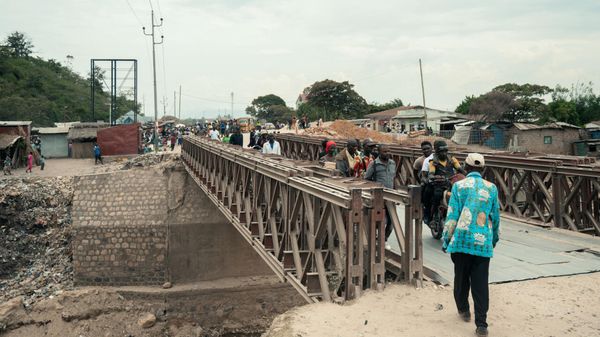
Arc'teryx Beta AR Stormhood Jacket (2023): first impressions
Since we tested this jacket, Arc'teryx has released an updated version that features PFAS-free Gore-Tex and a new pattern to cut down on waste. For this article, we've tested the previous iteration, first released in 2023.
The story of the Arc'teryx Beta AR actually goes all the way back to the year 2000, with the release of the brand's first "all-rounder" jacket. Various updates over the years have made the jacket lighter, stronger, and more watertight, and with the 2023 edition came the addition of the awesome Stormhood.
Using the ultra-durable Gore-Tex Pro waterproof membrane, this is a hardshell waterproof jacket that's virtually bombproof against wind and precipitation, but relatively light compared to its competition. Arc'teryx Watertight Zippers throughout ensure there are no weak points where water can leak in.
The main talking point is that Stormhood, which is big enough to wear over your ski helmet, but has two cinches at the back to draw it tight when you're just wearing a beanie, and they're big enough to operate with gloves on. A high collar protects your face when it's fully zipped up, though without a helmet, there is a slight gap at either side where some rain or snow gets in if the wind is howling.
• List price: $600 / £550
• Models available: Men's and women's
• Construction: 3-layer
• Weight (women's S): 13oz / 380g
• Sizes: Men's: XS - XXXL / Women's: XS - XXL
• Materials: 3L Gore-Tex Pro membrane, 40D & 80D Nylon
• Colors: Black, Dynasty, Amaranthus, Heritage Red
• Best use: Hiking, mountaineering, snow sports
The fabric is pliable enough to allow for lots of movement, and while, like any hardshell, it's not the most breathable for summer conditions, it is equipped with pit zips and makes an excellent choice for most mountain pursuits the rest of the year.
The regular cut allows plenty of room for multiple layers, and the design is lower at the back for extra protectio,n which comes in handy if you want to wear it for skiing. The hem is adjustable, as are the cuffs, when you need to call in reinforcements against the weather.
With two hand-warming pockets and an inner chest pocket that's just big enough for the largest Android phones, you'll have plenty of available storage in theory, though the outer pockets become a bit redundant once you're wearing a backpack. This is something a two-way zipper would help with.
As usual, when it comes to Arc'teryx, this jacket is extremely pricey, which does make it out of reach for many. But for the price, you do get the highest quality build, and thanks to the Arc'teryx ReBIRD program, a jacket that should last for decades.
Arc'teryx Beta AR Stormhood Jacket (2023): in the field

I've been hiking in the Arc'teryx Beta LT jacket for a couple of years, which offers really great, lightweight weather protection, but for the trek to Everest Base Camp, I was aware I'd need more protection, so I took the Beta AR Stormhood.
I made sure to test it out on some rainy hikes in Scotland and the Yorkshire Dales before I left for Nepal, and even though we were quite lucky with the weather on the way to Base Camp, I did end up wearing it against a couple of afternoon thunderstorms and at the highest altitudes over my fleece for wind protection.
I also recently brought it along on a five-day thru-hike in the Lake District, where I ended up wearing it for the last three days against some torrential rain and heavy showers.
Here's how it performed:
Sizing and fit
I tested a Small, which is my usual size. While previous Arc'teryx Beta jackets have proven to be a little roomy on me in that size, I think this is just about perfect. It's not quite as neat as it might be, but I can easily wear it over a base layer and a down jacket, which is most important when it comes to choosing a shell for wintery conditions.
The drop tail covers my bum completely for added protection, the sleeves come to my knuckles, and the collar up to my nose when I'm zipped up. It's not quite as long as the Beta LT, but I think it's more functional at this length and wouldn't change a thing.

Weight and packability
This isn't the lightest waterproof jacket I've tested, but considering it's a three-layer hardshell, it's surprisingly light and packable, which came in handy on the trek to Base Camp, since it mostly stayed packed away inside my backpack and didn't take up too much room.
I've tested lighter waterproofs, such as the Rab Firewall Alpine, but that's meant for milder conditions and moving fast. In build and performance, this is pretty similar to my Mountain Equipment Makalu Jacket, but it is quite a bit lighter, which makes it more appealing for longer expeditions.

Weather protection and breathability
This jacket is nearly bulletproof against the wind, rain, and hail, with one exception, which I'll get to in a moment. I've had it on in a couple of brief but heavy downpours in the Himalayas, but the biggest test was during a five-day, 75-mile trek where I saw a lot of very wet weather and worse it for about eight hours a day.
Despite some intense rain, the fabric hasn't wetted out yet and the hood is pretty fantastic in a storm. I've tested it with my climbing and skiing helmets, and it fits easily over both. Sometimes I find helmet-compatible hoods to be a little too large without a helmet, but this one can be adjusted to be quite snug and cocoon-like, with toggles I was able to adjust while wearing thick gloves in Nepal, and a nice laminated peak to keep the rain out of my eyes.
The only issue, which is one I've found common with helmet-compatible hoods, is that there is a slight gap on either side of my jaw, which I've discovered does let precipitation in if the conditions are especially nasty, and after hiking in heavy rain I did notice that my chest area was soaked through.
Overall, it excels at wind protection, and for the highest days in the Himalayas, where we were dealing with some gusts but also climbing quite vigorously, I found it to be a better choice than pulling on a down jacket. I ended up wearing it for several days of trekking over my fleece in the early mornings and staying quite comfortable.
That said, for milder Scottish summer conditions, it's about as breathable as I expect a hardshell to be, and that's to say it's not very breathable if you're climbing. The pit zips do help, and I've tested worse, but I'd probably choose the LT over this one during the summer months at lower altitudes.

Storage and other details
The hand-warming pockets are nice and deep, so they're functional from that perspective, but as is so often the case, they're not really usable once I've got my backpack on. Fortunately, the inner pocket was plenty big enough for my iPhone, and is just big enough for my new Android, which means I can keep my phone protected but close for pictures.
The other main detail to mention is the addition of a RECCO reflector built into the hood, which has been a feature of the Beta AR since 2020. This won't activate if you get lost or injured in the backcountry, but it could make you more searchable if disaster strikes, and I like to think that every little bit helps out there in the wild.







